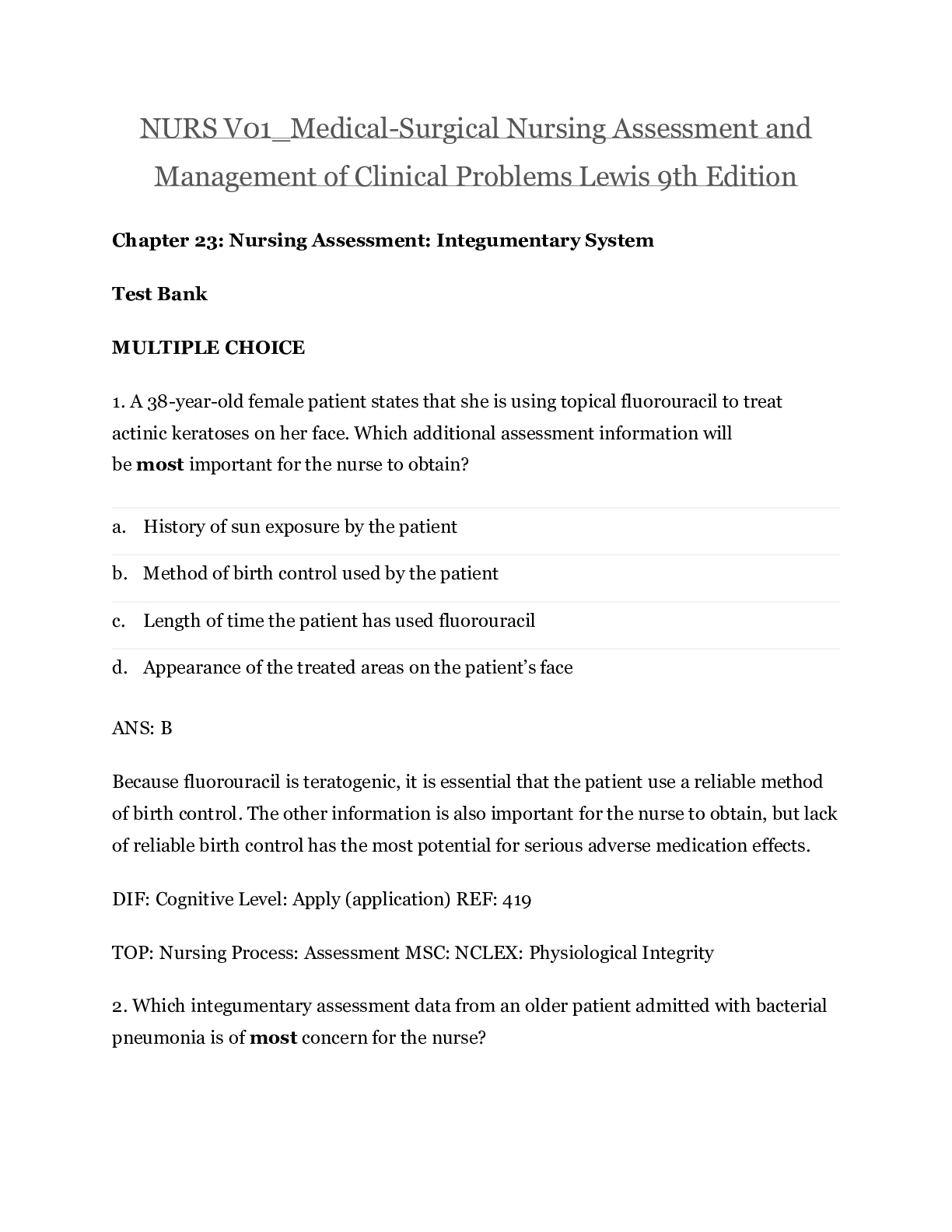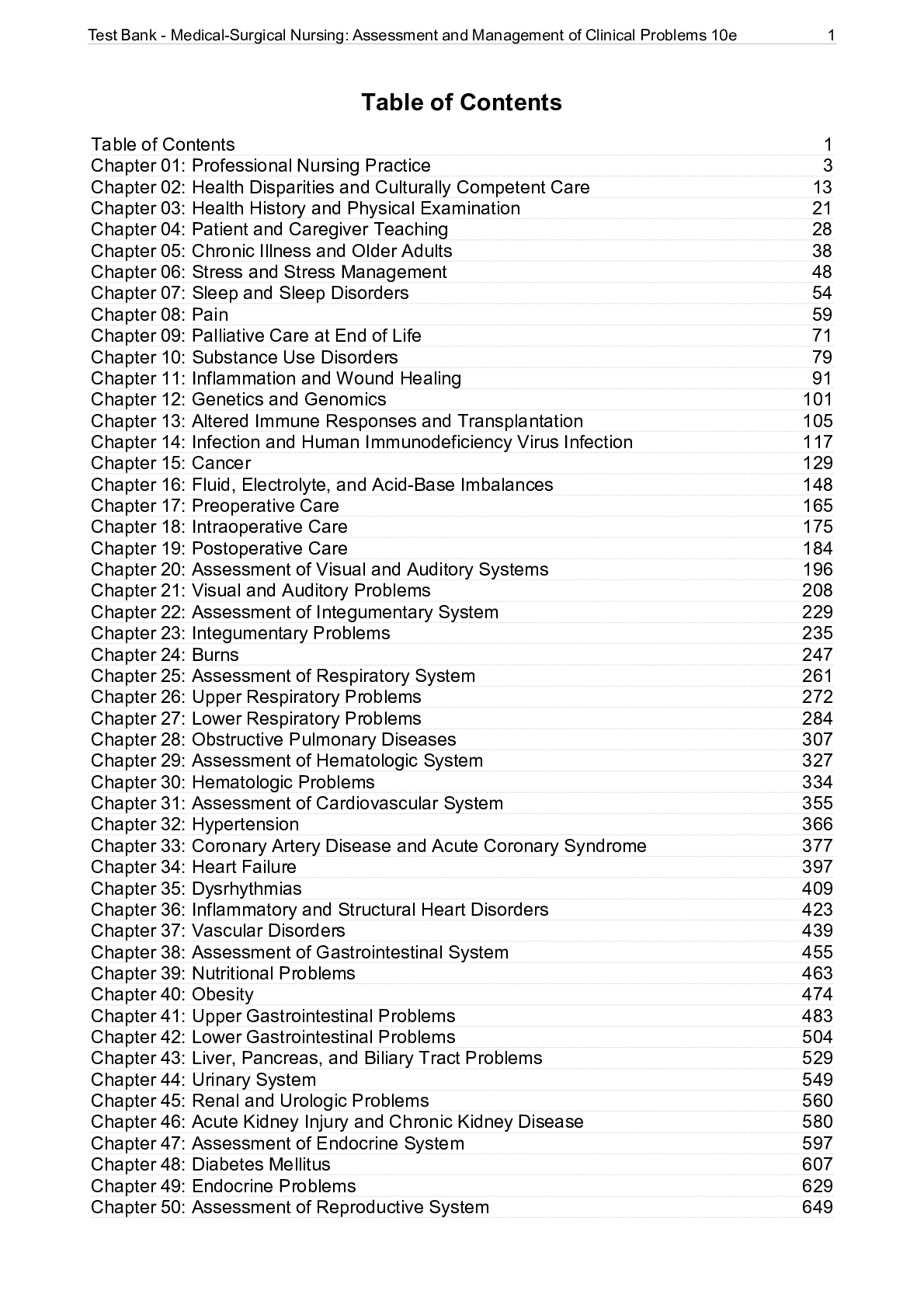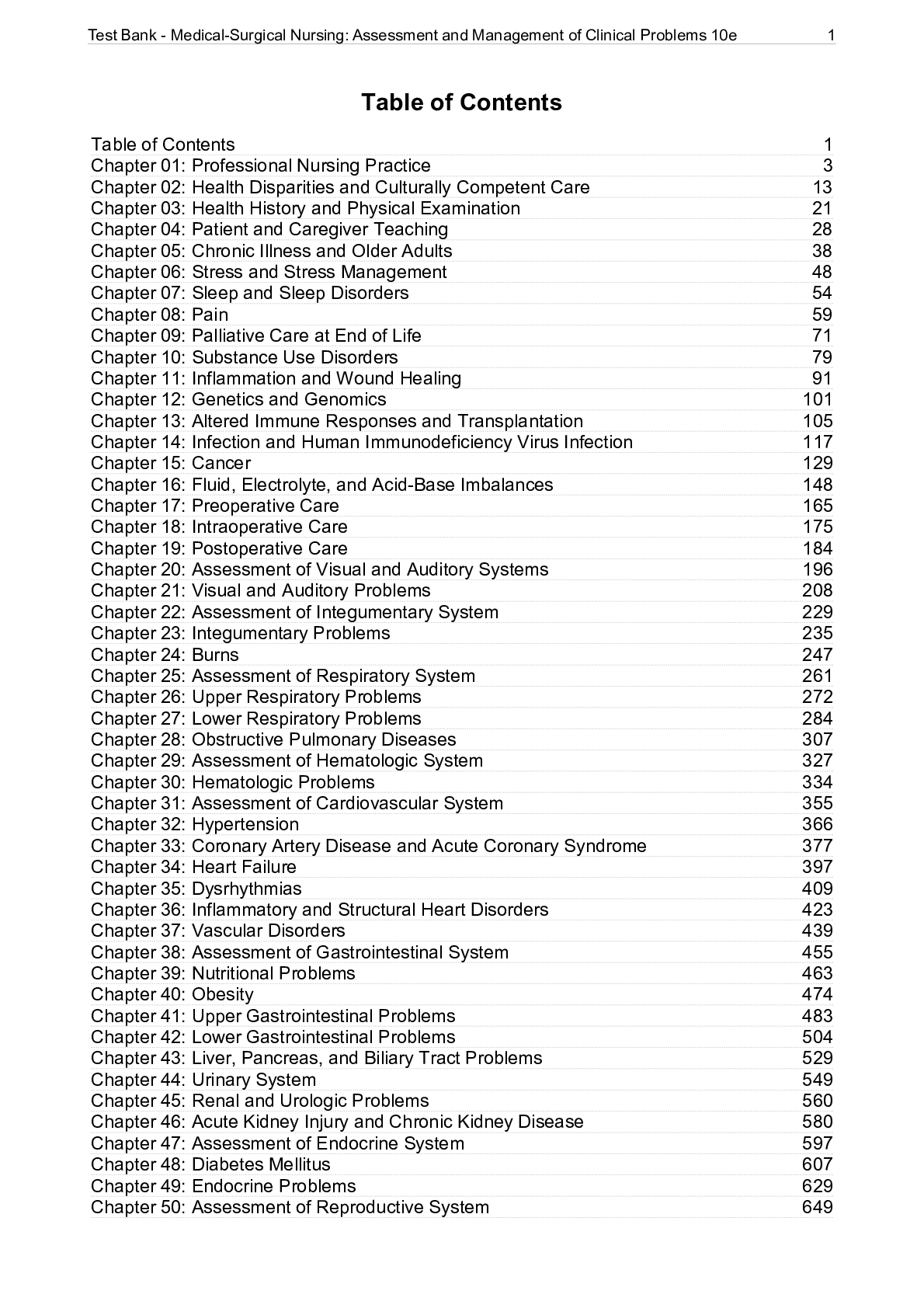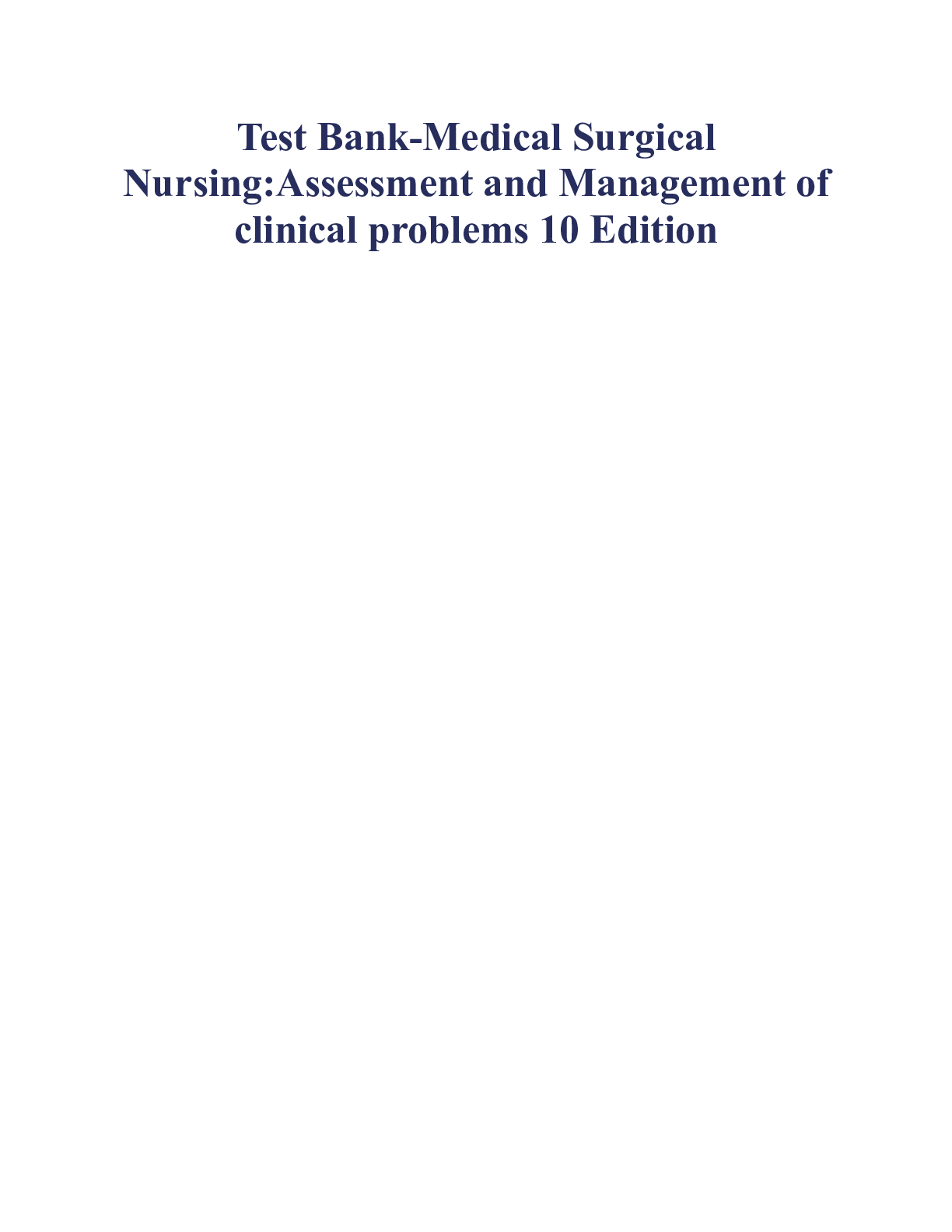Medical Studies > EXAM > NURS V01_Medical-Surgical Nursing Assessment and Management of Clinical Problems Lewis 9th Edition | (All)
NURS V01_Medical-Surgical Nursing Assessment and Management of Clinical Problems Lewis 9th Edition | Chapter 23: Nursing Assessment: Integumentary System
Document Content and Description Below
NURS V01_Medical-Surgical Nursing Assessment and Management of Clinical Problems Lewis 9th Edition Chapter 23: Nursing Assessment: Integumentary System Test Bank MULTIPLE CHOICE 1. A 38-year-old ... female patient states that she is using topical fluorouracil to treat actinic keratoses on her face. Which additional assessment information will be most important for the nurse to obtain? a. History of sun exposure by the patient b. Method of birth control used by the patient c. Length of time the patient has used fluorouracil d. Appearance of the treated areas on the patient’s face ANS: B Because fluorouracil is teratogenic, it is essential that the patient use a reliable method of birth control. The other information is also important for the nurse to obtain, but lack of reliable birth control has the most potential for serious adverse medication effects. DIF: Cognitive Level: Apply (application) REF: 419 TOP: Nursing Process: Assessment MSC: NCLEX: Physiological Integrity 2. Which integumentary assessment data from an older patient admitted with bacterial pneumonia is of most concern for the nurse? a. Reports a history of allergic rashes b. Scattered macular brown areas on extremities c. Skin brown and wrinkled, skin tenting on forearm d. Longitudinal nail bed ridges noted; sparse scalp hair ANS: A Because the patient will be receiving antibiotics to treat the pneumonia, the nurse should be most concerned about her history of allergic rashes. The nurse needs to do further assessment of possible causes of the allergic rashes and whether she has ever had allergic reactions to any drugs, especially antibiotics. The assessment data in the other response would be normal for an older patient. DIF: Cognitive Level: Apply (application) REF: 418-419 TOP: Nursing Process: Assessment MSC: NCLEX: Physiological Integrity 3. The nurse assesses a circular, flat, reddened lesion about 5 cm in diameter on a middle-aged patient’s ankle. How should the nurse determine if the lesion is related to intradermal bleeding? a. Elevate the patient’s leg. b. Press firmly on the lesion. c. Check the temperature of the skin around the lesion. d. Palpate the dorsalis pedis and posterior tibial pulses. ANS: B If the lesion is caused by intradermal or subcutaneous bleeding or a nonvascular cause, the discoloration will remain when direct pressure is applied to the lesion. If the lesion is caused by blood vessel dilation, blanching will occur with direct pressure. The other assessments will assess circulation to the leg, but will not be helpful in determining the etiology of the lesion. DIF: Cognitive Level: Apply (application) REF: 421 TOP: Nursing Process: Assessment MSC: NCLEX: Physiological Integrity 4. When examining an older patient in the home, the home health nurse notices irregular patterns of bruising at different stages of healing on the patient’s body. Which action should the nurse take first? a. Discourage the use of throw rugs throughout the house. b. Ensure the patient has a pair of shoes with non-slip soles. c. Talk with the patient alone and ask about what caused the bruising. d. Notify the health care provider so that x-rays can be ordered as soon as possible. ANS: C The nurse should note irregular patterns of bruising, especially in the shapes of hands or fingers, in different stages of resolution. These may be indications of other health problems or abuse, and should be further investigated. It is important that the nurse interview the patient alone because, if mistreatment is occurring, the patient may not disclose it in the presence of the person who may be the abuser. Throw rugs and shoes with slippery surfaces may contribute to falls. X-rays may be needed if the patient has fallen recently and also has complaints of pain or decreased mobility. However, the nurse’s first nursing action is to further assess the patient. DIF: Cognitive Level: Apply (application) REF: 421 TOP: Nursing Process: Implementation MSC: NCLEX: Health Promotion and Maintenance 5. A dark-skinned patient has been admitted to the hospital with chronic heart failure. How would the nurse best assess this patient for cyanosis? a. Assess the skin color of the earlobes. b. Apply pressure to the palms of the hands. c. Check the lips and oral mucous membranes. d. Examine capillary refill time of the nail beds. ANS: C Cyanosis in dark-skinned individuals is more easily seen in the mucous membranes. Earlobe color may change in light-skinned individuals, but this change in skin color is difficult to detect on darker skin. Application of pressure to the palms of the hands and nail bed assessment would check for adequate circulation but not for skin color. DIF: Cognitive Level: Apply (application) REF: 421 TOP: Nursing Process: Assessment MSC: NCLEX: Physiological Integrity 6. The nurse prepares to obtain a culture from a patient who has a possible fungal infection on the foot. Which items should the nurse gather for this procedure? a. Sterile gloves b. Patch test instruments c. Cotton-tipped applicators d. Local anesthetic, syringe, and intradermal needle ANS: C Fungal cultures are obtained by swabbing the affected area of the skin with cotton-tipped applicators. Sterile gloves are not needed because it is not a sterile procedure. Local injection is not needed because the swabbing is not usually painful. The patch test is done to determine whether a patient is allergic to specific testing material, not for obtaining fungal specimens. DIF: Cognitive Level: Apply (application) REF: 425 TOP: Nursing Process: Implementation MSC: NCLEX: Physiological Integrity - - - - - - - - - - - - - - - - - - - - - - - - - - - - - - - - - - - - MSC: NCLEX: Physiological Integrity 14. A postoperative patient has not voided for 8 hours after return to the clinical unit. Which action should the nurse take first? a. Perform a bladder scan. b. Encourage increased oral fluid intake. c. Assist the patient to ambulate to the bathroom. d. Insert a straight catheter as indicated on the PRN order. ANS: A The initial action should be to assess the bladder for distention. If the bladder is distended, providing the patient with privacy (by walking with them to the bathroom) will be helpful. Because of the risk for urinary tract infection, catheterization should only be done after other measures have been tried without success. There is no indication to notify the surgeon about this common postoperative problem unless all measures to empty the bladder are unsuccessful. DIF: Cognitive Level: Apply (application) REF: 360-361 OBJ: Special Questions: Prioritization TOP: Nursing Process: Implementation MSC: NCLEX: Physiological Integrity 15. The nurse is caring for a patient the first postoperative day following a laparotomy for a small bowel obstruction. The nurse notices new bright-red drainage about 5 cm in diameter on the dressing. Which action should the nurse take first? a. Reinforce the dressing. b. Apply an abdominal binder. c. Take the patient’s vital signs. d. Recheck the dressing in 1 hour for increased drainage. ANS: C New bright-red drainage may indicate hemorrhage, and the nurse should initially assess the patient’s vital signs for tachycardia and hypotension. The surgeon should then be notified of the drainage and the vital signs. The dressing may be changed or reinforced, based on the surgeon’s orders or institutional policy. The nurse should not wait an hour to recheck the dressing. DIF: Cognitive Level: Apply (application) REF: 355 OBJ: Special Questions: Prioritization TOP: Nursing Process: Implementation MSC: NCLEX: Physiological Integrity 16. When caring for a patient the second postoperative day after abdominal surgery for removal of a large pancreatic cyst, the nurse obtains an oral temperature of 100.8° F. Which action should the nurse take first? a. Have the patient use the incentive spirometer. b. Assess the surgical incision for redness and swelling. c. Administer the ordered PRN acetaminophen (Tylenol). d. Ask the health care provider to prescribe a different antibiotic. ANS: A A temperature of 100.8° F in the first 48 hours is usually caused by atelectasis, and the nurse should have the patient cough and deep breathe. This problem may be resolved by nursing intervention, and therefore notifying the health care provider is not necessary. Acetaminophen will reduce the temperature, but it will not resolve the underlying respiratory congestion. Because a wound infection does not usually occur before the third postoperative day, a wound infection is not a likely source of the elevated temperature. DIF: Cognitive Level: Apply (application) REF: 359 OBJ: Special Questions: Prioritization TOP: Nursing Process: Implementation MSC: NCLEX: Physiological Integrity 17. The nurse assesses that the oxygen saturation is 89% in an unconscious patient who was transferred from surgery to the postanesthesia care unit (PACU) 15 minutes ago. Which action should the nurse take first? a. Elevate the patient’s head. b. Suction the patient’s mouth. c. Increase the oxygen flow rate. d. Perform the jaw-thrust maneuver. ANS: D In an unconscious postoperative patient, a likely cause of hypoxemia is airway obstruction by the tongue, and the first action is to clear the airway by maneuvers such as the jaw thrust or chin lift. Increasing the oxygen flow rate and suctioning are not helpful when the airway is obstructed by the tongue. Elevating the patient’s head will not be effective in correcting the obstruction but may help with oxygenation after the patient is awake. DIF: Cognitive Level: Apply (application) REF: 351 | 352 | 323 OBJ: Special Questions: Prioritization TOP: Nursing Process: Implementation MSC: NCLEX: Physiological Integrity 18. The nurse assesses a patient who had a total abdominal hysterectomy 2 days ago. Which information about the patient is most important to communicate to the health care provider? a. The right calf is swollen, warm, and painful. b. The patient’s temperature is 100.3° F (37.9° C). c. The 24-hour oral intake is 600 mL greater than the total output. d. The patient complains of abdominal pain at level 6 (0 to 10 scale) when ambulating. ANS: A The calf pain, swelling, and warmth suggest that the patient has a deep vein thrombosis, which will require the health care provider to order diagnostic tests and/or anticoagulants. Because the stress response causes fluid retention for the first 2 to 5 days postoperatively, the difference between intake and output is expected. A temperature elevation to 100.3° F on the second postoperative day suggests atelectasis, and the nurse should have the patient deep breathe and cough. Pain with ambulation is normal, and the nurse should administer the ordered analgesic before patient activities. DIF: Cognitive Level: Apply (application) REF: 363 OBJ: Special Questions: Prioritization TOP: Nursing Process: Assessment MSC: NCLEX: Physiological Integrity 19. A patient who had knee surgery received intramuscular ketorolac (Toradol) 30 minutes ago and continues to complain of pain at a level of 7 (0 to 10 scale). Which action is best for the nurse to take at this time? a. Administer the prescribed PRN IV morphine sulfate. b. Notify the health care provider about the ongoing knee pain. c. Reassure the patient that postoperative pain is expected after knee surgery. d. Teach the patient that the effects of ketorolac typically last about 6 to 8 hours. ANS: A The priority at this time is pain relief. Concomitant use of opioids and nonsteroidal antiinflammatory drugs (NSAIDs) improves pain control in postoperative patients. Patient teaching and reassurance are appropriate, but should be done after the patient’s pain is relieved. If the patient continues to have pain after the morphine is administered, the health care provider should be notified. DIF: Cognitive Level: Apply (application) REF: 358 OBJ: Special Questions: Prioritization TOP: Nursing Process: Implementation MSC: NCLEX: Safe and Effective Care Environment 20. The nurse working in the postanesthesia care unit (PACU) notes that a patient who has just been transported from the operating room is shivering and has a temperature of 96.5° F (35.8° C). Which action should the nurse take? a. Cover the patient with a warm blanket and put on socks. b. Notify the anesthesia care provider about the temperature. c. Avoid the use of opioid analgesics until the patient is warmer. d. Administer acetaminophen (Tylenol) 650 mg suppository rectally. ANS: A The patient assessment indicates the need for active rewarming. There is no indication of a need for acetaminophen. Opioid analgesics may help reduce shivering. Because hypothermia is common in the immediate postoperative period, there is no need to notify the anesthesia care provider, unless the patient continues to be hypothermic after active rewarming. DIF: Cognitive Level: Apply (application) REF: 359 TOP: Nursing Process: Implementation MSC: NCLEX: Physiological Integrity 21. The nurse reviews the laboratory results for a patient on the first postoperative day after a hiatal hernia repair. Which finding would indicate to the nurse that the patient is at increased risk for poor wound healing? a. Potassium 3.5 mEq/L b. Albumin level 2.2 g/dL c. Hemoglobin 11.2 g/dL d. White blood cells 11,900/µL ANS: B Because proteins are needed for an appropriate inflammatory response and wound healing, the low serum albumin level (normal level 3.5 to 5.0 g/dL) indicates a risk for poor wound healing. The potassium level is normal. Because a small amount of blood loss is expected with surgery, the hemoglobin level is not indicative of an increased risk for wound healing. WBC count is expected to increase after surgery as a part of the normal inflammatory response. DIF: Cognitive Level: Apply (application) REF: 173 TOP: Nursing Process: Assessment MSC: NCLEX: Physiological Integrity 22. The nurse assesses a patient on the second postoperative day after abdominal surgery to repair a perforated duodenal ulcer. Which finding is most important for the nurse to report to the surgeon? a. Tympanic temperature 99.2° F (37.3° C) b. Fine crackles audible at both lung bases c. Redness and swelling along the suture line d. 200 mL sanguineous fluid in the wound drain ANS: D Wound drainage should decrease and change in color from sanguineous to serosanguineous by the second postoperative day. The color and amount of drainage for this patient are abnormal and should be reported. Redness and swelling along the suture line and a slightly elevated temperature are normal signs of postoperative inflammation. Atelectasis is common after surgery. The nurse should have the patient cough and deep breathe, but there is no urgent need to notify the surgeon. DIF: Cognitive Level: Apply (application) REF: 361 OBJ: Special Questions: Prioritization TOP: Nursing Process: Assessment MSC: NCLEX: Safe and Effective Care Environment 23. After receiving change-of-shift report about these postoperative patients, which patient should the nurse assess first? a. Obese patient who had abdominal surgery 3 days ago and whose wound edges are separating b. Patient who has 30 mL of sanguineous drainage in the wound drain 10 hours after hip replacement surgery c. Patient who has bibasilar crackles and a temperature of 100°F (37.8°C) on the first postoperative day after chest surgery d. Patient who continues to have incisional pain 15 minutes after hydrocodone and acetaminophen (Vicodin) administration ANS: A The patient’s history and assessment suggests possible wound dehiscence, which should be reported immediately to the surgeon. Although the information about the other patients indicates a need for ongoing assessment and/or possible intervention, the data do not suggest any acute complications. Small amounts of red drainage are common in the first postoperative hours. Bibasilar crackles and a slightly elevated temperature are common after surgery, although the nurse will need to have the patient cough and deep breathe. Oral medications typically take more than 15 minutes for effective pain relief. DIF: Cognitive Level: Analyze (analysis) REF: 361 OBJ: Special Questions: Prioritization TOP: Nursing Process: Assessment MSC: NCLEX: Safe and Effective Care Environment OTHER 1. While ambulating in the room, a patient complains of feeling dizzy. In what order will the nurse accomplish the following activities? (Put a comma and a space between each answer choice [A, B, C, D].) a. Have the patient sit down in a chair. b. Give the patient something to drink. c. Take the patient’s blood pressure (BP). d. Notify the patient’s health care provider. ANS: A, C, B, D The first priority for the patient with syncope is to prevent a fall, so the patient should be assisted to a chair. Assessment of the BP will determine whether the dizziness is due to orthostatic hypotension, which occurs because of hypovolemia. Increasing the fluid intake will help prevent orthostatic dizziness. Because this is a common postoperative problem that is usually resolved through nursing measures such as increasing fluid intake and making position changes more slowly, there is no urgent need to notify the health care provider. DIF: Cognitive Level: Apply (application) REF: 357 OBJ: Special Questions: Prioritization TOP: Nursing Process: Implementation MSC: NCLEX: Physiological Integrity 2. A patient’s blood pressure in the postanesthesia care unit (PACU) has dropped from an admission blood pressure of 140/86 to 102/60 with a pulse change of 70 to 96. SpO2 is 92% on 3 L of oxygen. In which order should the nurse take these actions? (Put a comma and a space between each answer choice [A, B, C, D].) a. Increase the IV infusion rate. b. Assess the patient’s dressing. c. Increase the oxygen flow rate. d. Check the patient’s temperature. ANS: A, C, B, D The first nursing action should be to increase the IV infusion rate. Because the most common cause of hypotension is volume loss, the IV rate should be increased. The next action should be to increase the oxygen flow rate to maximize oxygenation of hypoperfused organs. Because hemorrhage is a common cause of postoperative volume loss, the nurse should check the dressing. Finally, the patient’s temperature should be assessed to determine the effects of vasodilation caused by rewarming. DIF: Cognitive Level: Analyze (analysis) REF: 355-356 OBJ: Special Questions: Prioritization TOP: Nursing Process: Implementation MSC: NCLEX: Physiological Integrity [Show More]
Last updated: 1 year ago
Preview 1 out of 142 pages
Instant download

Buy this document to get the full access instantly
Instant Download Access after purchase
Add to cartInstant download
Reviews( 0 )
Document information
Connected school, study & course
About the document
Uploaded On
Aug 04, 2020
Number of pages
142
Written in
Additional information
This document has been written for:
Uploaded
Aug 04, 2020
Downloads
0
Views
48




















